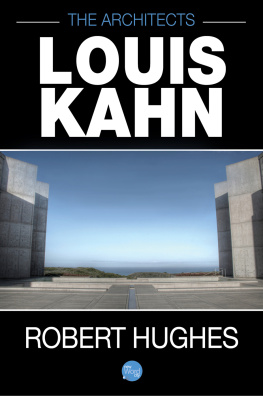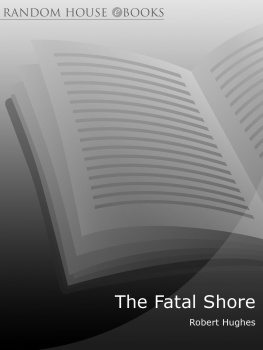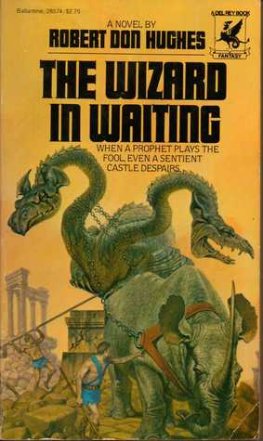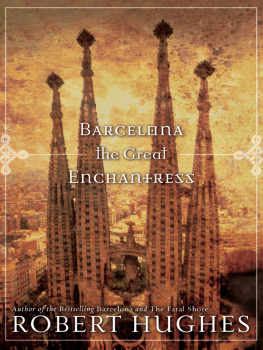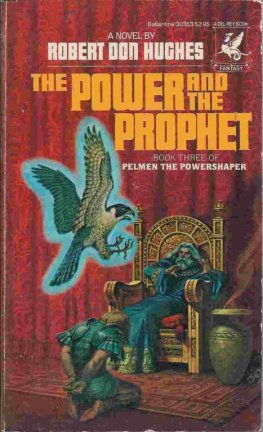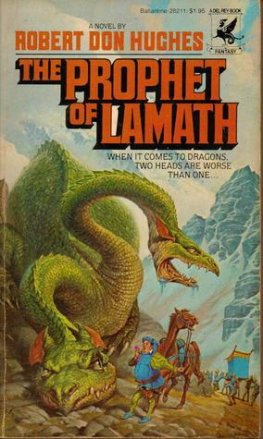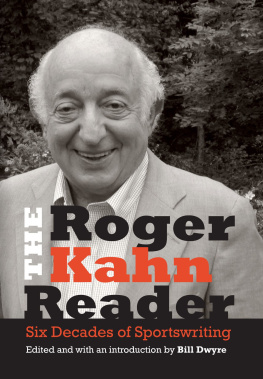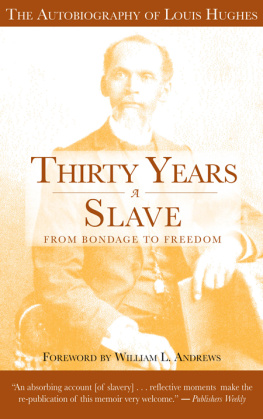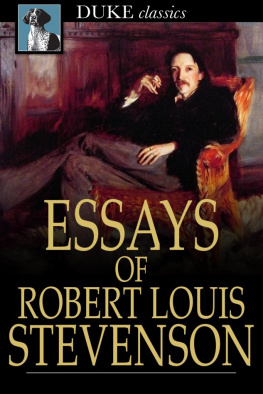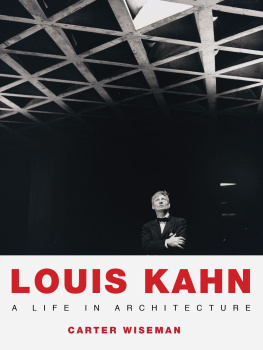Robert Hughes - The Architects: Louis Kahn
Here you can read online Robert Hughes - The Architects: Louis Kahn full text of the book (entire story) in english for free. Download pdf and epub, get meaning, cover and reviews about this ebook. year: 2015, publisher: New Word City, Inc., genre: Detective and thriller. Description of the work, (preface) as well as reviews are available. Best literature library LitArk.com created for fans of good reading and offers a wide selection of genres:
Romance novel
Science fiction
Adventure
Detective
Science
History
Home and family
Prose
Art
Politics
Computer
Non-fiction
Religion
Business
Children
Humor
Choose a favorite category and find really read worthwhile books. Enjoy immersion in the world of imagination, feel the emotions of the characters or learn something new for yourself, make an fascinating discovery.
- Book:The Architects: Louis Kahn
- Author:
- Publisher:New Word City, Inc.
- Genre:
- Year:2015
- Rating:5 / 5
- Favourites:Add to favourites
- Your mark:
- 100
- 1
- 2
- 3
- 4
- 5
The Architects: Louis Kahn: summary, description and annotation
We offer to read an annotation, description, summary or preface (depends on what the author of the book "The Architects: Louis Kahn" wrote himself). If you haven't found the necessary information about the book — write in the comments, we will try to find it.
Louis Kahn was one of the most important architects of the twentieth century, hailed as a master of materials, but also of light. The plan of a building, he once said, should be read like a harmony of spaces created in light. Here, in this essay by the legendary art critic Robert Hughes, is Kahns story.
The Architects: Louis Kahn — read online for free the complete book (whole text) full work
Below is the text of the book, divided by pages. System saving the place of the last page read, allows you to conveniently read the book "The Architects: Louis Kahn" online for free, without having to search again every time where you left off. Put a bookmark, and you can go to the page where you finished reading at any time.
Font size:
Interval:
Bookmark:
Brick is stingy, concrete is generous.
- Louis Kahn
He was not, at first glimpse, an impressive man. If an architect is expected to resemble his structures, Louis Kahn would have been taller, thicker, and more athletic-looking. One did not expect the white-thatched hair with that hoarse, shrill voice and those shrewd, kindly eyes - nor did one expect the master of pure form to nest on a litter of Beaux-Arts tomes and black crayon sketches in a small office above Walnut Street, Philadelphia. His office, unlike the forbidding corporate hives in which many celebrated architectural firms conduct their weighty affairs, was a messy, ramshackle sequence of spaces cobbled together from unfinished sheet rock and two-by-fours, old filing cabinets, cubbyholes, and trestles. It fit perfectly with the rumpled, ready-made suits that hung, distended by wads of notepaper, from Kahns birdlike frame. Apart from his throat and chin - a pleated embroidery of ancient scar tissue from a childhood burn - Kahn was not in the least conspicuous. So, on the night of March 17, 1974, after he was found dead on the floor of Pennsylvania Station in New York, his corpse was shunted to the city morgue and remained there unclaimed for three days; only after his wife, Esther, made frantic calls to the New York police did the news surface that the body belonged to the man widely regarded as the worlds foremost living architect.
ARCHITECTURE, WROTE ARCHITECTURAL pioneer Charles-douard Jeanneret-Gris , known as Le Corbusier , is the skillful, correct, and magnificent play of forms under light. No modern American architect fulfilled the demands half-hidden in that aphorism more completely than Louis Kahn. Construction with any other purpose, Le Corbusier was implying, is just building. The architect is a mediator between substance and the light that manifests it. The building must proclaim at its fullest density, substance: solid, articulate, incontrovertible - monumental . The other half of the equation is light, that fugitive, unpr edictable energy by which space and surface become apparent. To open up the box, to pierce it and slice it, to release inside it a shifting pattern of gloom and illumination that will keep the eye (and the minds sense of scale) busy from dawn to dusk - such is the traditional enterprise of architecture.
Kahn was, by instinct, a monumentalizer . But there is irony in the fact that some of his best buildings, such as the Phillips Exeter Academy Library in Exeter, New Hampshire, and the Kimbell Museum in Fort Worth, Texas, were both completed in 1972, just as a strong anti- monumentalist sentiment crested . Many spokespeople of this new sentiment were at odds with one another but united in their rejection of sleek, massive urban buildings. Some critics attacked monumentalists for ignoring the problems of housing the poor. Others proposed the idea of architecture without architects, tribally or communally evolved, free from the authoritarian architect as master-planner . Another kind of anti-monumentalism was propounded by Robert Venturi and his disciples: pop architecture, ugly and ordinary, derived from American commercial ism - Levittown , strip malls , the exuberant, tinny vulgarity of Las Vegas .
The monuments these critics opposed were products of the International Style , the glass-box inherited from the Bauhaus and, by the sixties, in pathetic decline. Kahn, too, was searching for an alternative to so-called serious monumental architecture in America, but he went back to the despised tradition in which he had been brought up Beaux-Arts design - reinstated the Beaux-Arts philosophy as a creative proposition. What Kahn made of the Beaux-Arts tradition minus the caryatids, the scrolls, and volutes - constitutes one of the most brilliant contemporary meditations on the history of design.
The opposition between the Beaux-Arts mode, the basic academic form of the nineteenth century, and the International Style, which would become the same thing for the twentieth, is central to Kahns work. When you confront an International Style building - whether a work by the Bauhaus s founding fathers, Mies van der Rohe and Walter Gropius , or one of the innumerable versions of their glass box that shaped the American cityscape for decades - you are aware, first, of skin: the glass curtain wall, hung from the floors. The wall carries no load; its divisions are unobtrusive, slender, metal transoms. It is a two-dimensional web, with the interior structure veiled by glitter and reflections. The steel columns carry the weight; the floors dont need immovable supporting walls, and the space can be partitioned at will.
It was once an economical way to make large buildings. Today it is less so because large glass buildings need enormous amounts of energy to heat and cool. And it lacks soul: The blandness written into the flexibility of International Style space requires immense proportioning and detailing to overcome the boredom. The grave and hermetic elegance of Mies s Seagram Building on Park Avenue or Philip Johnsons Museum of Modern Art in New York, is rare. Form follo ws function is the catchword of rationalist design. When function is diffused or h omogenized, however (and in decay, the International Style became the epitome of the corporate notion that even e mployees are interchangeable parts), monsters are born - usually in the shape of the building at 1221 Avenue of the Americas in New York.
Kahn liked to correct the form-and-function clich. Form, he insisted, evokes function. There is no functional difference between the Spanish Steps in Rome, the flight that leads to the top of a Mayan pyramid , and the staircase of the Paris Opera , but the sensation of using them is, in each case, radically different. For Kahn, expression was a legitimate function of architecture that helped determine use. I dont believe in constructing a large space and then making partitioned areas within it and calling them rooms. A room should be an extension of self. In a large commercial auditorium, Id speak one way, but if I gave a talk in the Baptistery in Florence, I think I would say something Id never said before.
Kahns aesthetic of specific spaces was derived from what would have seemed, to any advanced young architect in the 1920s, a dangerously outdated and discredited system - the Beaux-Arts theory of design, passed down from such nineteenth-century exponents as Eugne Viollet-le-Duc , who led the Gothic Revival in France and restored the medieval town of Carcassonne. The Beaux-Arts wall was not a light skin: It was a thick extended skeleton. This perception does not, in itself, sound remarkable. But it was to have radical consequences.
Kahn was a product of Beaux-Arts discipline. In 1905, at age four, he had come to A merica from the Estonian island of Osel off the Russian coast. Decanted in Philadelphia, where the family lived in poverty for years, Kahn grew up an urban creature. Armed with a plethora of scholarships, he entered the Architectur e School of the University of Pennsylvania in 1920 and studied under the architect Paul Cret , a Beaux-Art enthusiast who designed - among other cur iosities of neoclassical revival architecture - the ponderous Folger Shakespeare Library in Washington, D.C.
He did not become aware of the modern movement until 1928, when he read some of Le Corbusiers essays. But that year, Kahn made his first trip to Europe, where his enthusiasm for Le Corbusiers ideas was tempered by his interest in great buildings from the past. What particularly impressed him was primitive architecture: the squat, dark, declarative columns of the temples at Paestum , and the early Romanesque architecture of Siena and San Gimignano .
His European trip gave Kahn motifs that would recur in his designs for years. The massive brick stair towers and service stacks that cluster around the main block of Kahns Richards Medical Research Building at the University of Pennsylvania reflect the square, brick lookout towers of thirteenth-century rival nobles in San Gimignano. The intricately cut spaces and curving orange walls of Kahns Institute of Management in Ahmadabad, India, look back with homage that originality pays tradition, to the vaults, crooks, and arches made by Sienese bricklayers.
Next pageFont size:
Interval:
Bookmark:
Similar books «The Architects: Louis Kahn»
Look at similar books to The Architects: Louis Kahn. We have selected literature similar in name and meaning in the hope of providing readers with more options to find new, interesting, not yet read works.
Discussion, reviews of the book The Architects: Louis Kahn and just readers' own opinions. Leave your comments, write what you think about the work, its meaning or the main characters. Specify what exactly you liked and what you didn't like, and why you think so.

